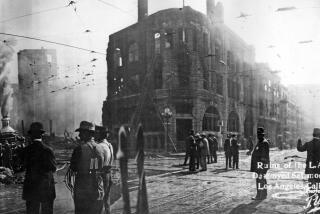Beatings of UAW Leaders Galvanized Union Drive
- Share via
Four organizers for the fledgling United Auto Workers union walked atop an overpass that led into the Ford Motor Co.’s massive River Rouge auto plant on the outskirts of Detroit.
The UAW activists, including 30-year-old Walter P. Reuther, had arrived on that day in May 1937 to oversee the leaflet effort, hoping to persuade Ford’s 80,000 Rouge workers to join the growing union.
The organizers were emboldened by the great sit-down strikes earlier that year in Flint, Mich., that prompted General Motors Corp. to recognize the union.
But Ford, then the nation’s most influential auto maker, vowed to keep the unions out. So as Reuther and his colleagues approached the Rouge, reporters and photographers in tow, the stage was set for a monumental confrontation.
They were surrounded by 40 burly, menacing-looking men. The Ford-hired thugs, who included a local boxing champion and several local gangsters, pounced on the union organizers, hitting and kicking them repeatedly.
The incident drew national attention as dramatic photographs of the bloody beatings appeared in newspapers and magazines around the world.
The unprovoked attack stands as an important turning point in American labor history. It not only turned public opinion in favor of the union cause, but catapulted Reuther, little known at the time, into national prominence.
Although he died in a plane crash in 1970, Reuther’s presence is still felt today. UAW leaders, struggling to maintain the union’s waning power, evoke his memory and often ponder when faced with difficult issues: “What would Walter do?”
“The complex and powerful legacy of his leadership remains a tangible presence not only with the UAW’s high councils, but for all who see the labor movement, as Reuther did, as an essential lever with which to reshape society,” wrote Nelson Lickenstein, a University of Virginia history professor and Reuther biographer.
Reuther oversaw the UAW during the auto industry’s glory days. He rose to the union’s presidency in 1947 and survived an assassination attempt shortly thereafter. His power over the nation’s industrial caldron was so great that George Romney, an auto executive who would become Michigan governor, called him “the most dangerous man in Detroit.”
Reuther’s philosophy was a blend of socialist idealism and realistic pragmatism.
A master negotiator, he brought a generation of blue-collar workers into the middle class. The UAW was a trend-setting union, winning such benefits as cost-of-living protection, pensions and fully paid medical coverage.
Reuther was considered so shrewd and visionary that one union official quipped, “He was the only man I ever knew that could reminisce about the future.”
Under his leadership, the UAW grew to more than 1.5 million members; about 30% of the U.S. work force belonged to a union.
But as its power grew, big labor gained a reputation for being as bullying and exploitative as big business. Its image was further tainted by corruption and alleged ties to communists and organized crime.
Other issues contributed to labor’s eventual decline. The wage and benefit increases of auto workers were paid for by higher consumer costs. Inflexible union work rules increased inefficiency.
When Japanese imports arrived on U.S. shores in the early 1970s, the Big Three and the UAW saw little threat from the small cars. But as Japanese quality and manufacturing improved--and oil prices skyrocketed--the industrial Midwest was hit by an economic tidal wave.
The Rust Belt went into a swoon as the auto, steel and other industrial sectors were hit with massive layoffs and plant closings. Union membership plummeted. Today the UAW has only 800,000 members, and fewer than half of those are auto workers. Only 13.9% of the nation’s work force is now unionized.
The union movement has lost momentum and political clout. The setbacks included the ill-fated air traffic controllers’ strike and labor’s failure to block the North American Free Trade Agreement, which it sees as a threat to high-paying U.S. jobs.
Young workers are increasingly difficult to attract. They take for granted the benefits that union laborers won but which are now offered at nonunion companies.
But there have been recent successes. The Teamsters won a popular strike against United Parcel Service. More service and professional workers show willingness to join unions.
Despite labor’s changes, its leaders still take a cue from Reuther. “We are a social movement,” said current UAW President Stephen P. Yokich, echoing Reuther’s philosophy of 70 years ago, “not just a collective bargaining agent.”






